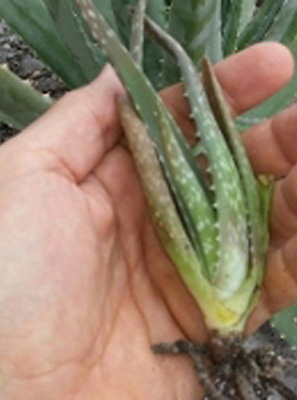
Our local customers always comment on how beautiful and big our Aloe leaves are. They see our aloe plants when they come to our home office to pick up their Aloe. Many will go into detail at how big their Aloe bushes are, but explain that they just don’t get big leaves like ours.
In this short video, Dr. Michael Haley of Stockton Aloe 1 explains why and how to pull and transplant Aloe vera pups.
In just two minutes of video, you’ll learn how and why to pull the pups, how to grow big healthy leaves, what kind of Aloe plants are good for making Aloe vera gel to drink, how old the leaves should be before consuming, and more.
But if you let your plant over-grow… you might need a more aggressive approach! In this next video, you will see a much more aggressive approach to cleaning your plant. Watch for the Surprise Ending!
If you just watched that video, you might think what I did to the plant was a bit too brutal. That is, you might suspect I KILLED it. If so, you won’t believe what happens in this next video:
Now that you know how to farm aloe vera plants, you need to know what to do with all of those HUGE leaves.
Do you want to learn more about transplanting and potting our aloe vera pups? Are you wondering what kind of soil to use? The answer may be shocking. You can find out more here.
We have more amazing videos in the making. Don’t forget to SUBSCRIBE to our YouTube channel.




Here in the northeaat, over the last 20 years, I’ve seen about 8 aloe vera plants growing indoors in various peoples homes. I also grew one myself for 6 months before giving it to a friend.
It appears that these plants, as well as the smaller pups in your videos, DO NOT produce 3 leaves at a time. Since some of the pups in your video also seem NOT to demonstrate the three leaf per layer growth trait, I am thinking this trait develops as the plant matures. However, I am not certain if this hypothesis is correct.
I want to know if the hypothesis is true or not because I was gifted a pot of aloe 4 months ago and now have 20 small plants. I don’t want to destroy them if they will eventually mature into large barbadensis plants, nor do I want to continue investing space and time into these plants if they will never attain the size necessary for consumption.
Another trait of the plants in question is that they are sprawling along the soil instead of growing erect. Is that a trait the barbadensis miller stockton will acquire when young if not properly cared for, or does the stockton always grow erect without an increasingly long weak stem as it matures from small pup to mature upright plant?
Any information that might shed light on why the average aloe vera plant here is so different from your mature plants will be greatly appreciated.
Gary Springer
Yes, you see the 3 leaf thing when they are mature. Also, they don’t mature much without gobs of sunlight. Indoors, they grow skinny long limp leaves.
Thank you for helping me understand the Aloe Vera plant!
One more question please; If I purchase a more mature aloe vera barbadensis miller plant with wide thick strong stems, and grow it indoors, then, over time, will it revert to the skinny limp plant that we typically see in homes here in the northeast, or, given some window light and electric lighting, will it continue to produce large thick leaves?
Thank you!!
Gary Springer
I have seen big thick healthy plants gradually get skinny after being moved in doors.
Hi!,
I have a small plant of the same species.. but I don’t see any “pups”. When abouts will they start growing? It’s a fairly small plant right now.
Jennifer Char
Jennifer, I don’t know for sure… but I think it was about 2 years before they were big enough and started producing their own pups.